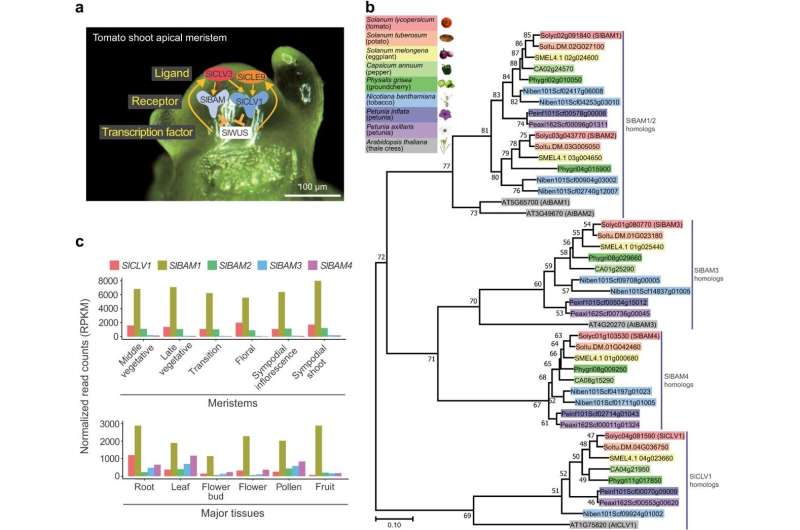This article has been reviewed according to Science X's editorial process and policies. Editors have highlighted the following attributes while ensuring the content's credibility:
fact-checked
peer-reviewed publication
trusted source
proofread
Stem cell harmony: How solanaceae plants maintain homeostasis through receptor compensation

A pivotal study sheds light on the evolutionary conservation of stem cell homeostasis in Solanaceae, revealing how receptor compensation mechanisms ensure the continuous and orderly formation of plant organs. This research uncovers the genetic interplay that maintains stem cell balance, offering new perspectives on crop improvement and resilience enhancement.
Stem cell homeostasis is vital for the continuous formation of plant organs. This process involves intricate interactions among peptide ligands and their receptor-like kinases. Due to the dynamic nature of plant genomes, understanding these mechanisms is crucial for improving crop resilience and productivity. Based on these challenges, it is essential to conduct in-depth research to explore the underlying genetic compensation mechanisms in plants.
In a study conducted by researchers from Kyung Hee University and Cold Spring Harbor Laboratory, and published on May 3, 2024, in Horticulture Research, the team explored the genetic compensation mechanisms that regulate stem cell homeostasis in Solanaceae species, particularly tomato and groundcherry. The study focuses on the compensation roles of CLAVATA1 (CLV1) and its paralogs, BARELY ANY MERISTEMs (BAMs), through CRISPR-Cas9 genome editing.
Using CRISPR-Cas9, researchers generated higher-order mutants in tomato and groundcherry to investigate receptor gene compensation mechanisms. They discovered that SlBAM1 and SlBAM2 in tomato effectively compensate for slclv1 mutations, ensuring stem cell proliferation without the need to upregulate other BAM genes. Similar compensation mechanisms were found in groundcherry.
The study highlighted that critical amino acid residues involved in peptide ligand interactions are highly conserved across these species, providing a robust buffering capacity for stem cell homeostasis. This conservation underscores the evolutionary preservation of genetic compensation mechanisms within the Solanaceae family, illustrating how these plants maintain essential functions despite genetic perturbations. These findings offer new insights into the genetic robustness of plants and have significant implications for enhancing crop resilience and productivity.
Dr. Choon-Tak Kwon, the lead researcher from Kyung Hee University, stated, "Our findings demonstrate a remarkable evolutionary conservation of genetic compensation mechanisms in plants. Understanding these mechanisms opens new avenues for enhancing crop resilience and productivity by leveraging the inherent genetic robustness in plant species."
The insights gained from this study have significant implications for agricultural practices. By understanding the genetic compensation mechanisms in plants, breeders can develop more resilient crops that can better withstand environmental stresses. This research paves the way for innovative approaches to crop improvement, ensuring sustainable agricultural practices and food security.
More information: Myeong-Gyun Seo et al, Evolutionary conservation of receptor compensation for stem cell homeostasis in Solanaceae plants, Horticulture Research (2024). DOI: 10.1093/hr/uhae126
Journal information: Horticulture Research
Provided by NanJing Agricultural University




















